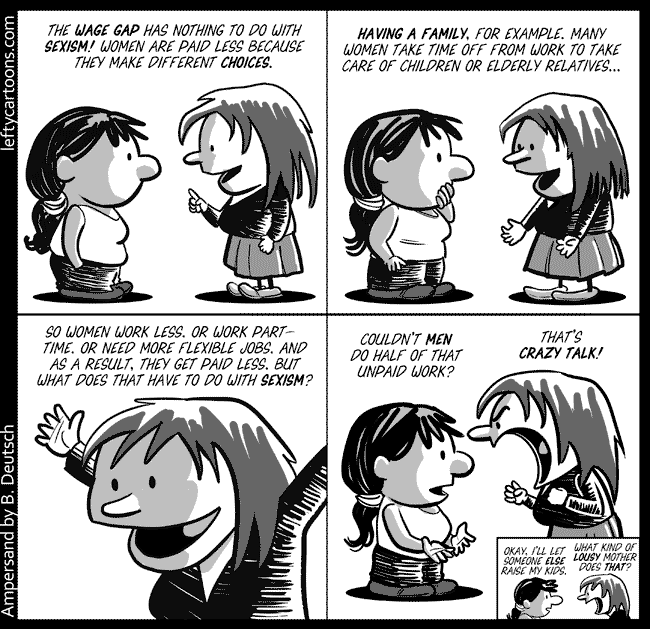Why The "Wage Gap Myth" Is Not Really a Myth

By:
There are often assertions that the gender wage gap is a myth, despite the fact that there are high-profile anecdotes that point to a pay gap—Jennifer Lawrence and Sienna Miller for example.
Further, as is shown in the comic by Barry Deutsch from leftycartoons.com, the reality of the wage gap goes far beyond stories about unfair paychecks. The root of the disparity in wages for men and women is in our construction of gender.
 B. Deutsch - leftycartoons.com
B. Deutsch - leftycartoons.com
The wage gap.
The wage gap between men and women exists, however, there is some discrepancy on the actual figure.
"On average, full-time working women earn just 78 cents for every dollar a man earns," says a White House page about the pay gap between men and women. Presidential candidate Bernie Sanders has repeated this statistic, and Hilary Clinton said 77 cents last year. (This figure is lower for women of color.)
The 77 cents or 78 cents per a man's dollar figures come from different reports from the Census Bureau (PDF), which show the median income of men and women. When that data is analyzed, you find women earn about 77 or 78 percent of what men earn. That would seem to show that men earn more than women.
However, In a 2014 article titled "No, Women Don’t Make Less Money Than Men," Daily Beast contributor Christina Hoff Sommers (of the right of center American Enterprise Institute) asserts there is only a very small pay gap.
"It does not account for differences in occupations, positions, education, job tenure, or hours worked per week," Sommers wrote of the Census Bureau statistic. "When all these relevant factors are taken into consideration, the wage gap narrows to about five cents."
She wrote this five cent difference could either be attributed to discrimination or external factors—women ask for raises less than men, they take off more time for childcare, and that they typically choose less lucrative fields than men. Sommers notes the top ten college majors that pay big money (engineering jobs and pharmaceuticals) are mostly taken by men, while the bottom ten majors for making the most money (childcare, social work, the arts) are largely populated by women.
So why is there a wage gap?
Sommers' view is not an entirely fair way to examine the wage gap. Regardless if the gap is five cents or 50 cents, inherent social conditioning plays a large role in why women may select certain jobs, not ask for a raise, or be relied upon to care for a family—which is the direct result of a past when men were the family breadwinners.
The many letters to the editor published after the Wall Street Journal ran a story about the wage gap "myth" explain part of the reason there is a gap, regardless of what size that gap is.
"Women historically don't work the same jobs or hours due to family responsibilities, and they have been culturally conditioned away from jobs with risk or that require STEM education," a Wall Street Journal reader wrote. "The choice of a college major and profession is 'free' for women if we reject social construction. You cannot factor out proxies for gender discrimination, as the authors do, when these 'variables' contextualize every dollar people make. The gender pay gap is a direct result of gender discrimination."
Social conditioning.
As many have said before, teachers and parents tend to think of science, technology and math as guy things, so they encourage girls to focus on other subjects, which can lead to careers in less lucrative fields, even though many girls are very gifted in STEM (science, technology, engineering and mathematics) subject matters.
"Stop telling girls they can be anything they want when they grow up,” Sarah Silverman jokes in her comedy special "We Are Miracles." “I think it’s a mistake. Not because they can’t, but because it would’ve never occurred to them they couldn’t."
The role as primary caregiver.
Another contributor to the wage gap derived from society's expectations is care-giving. Women often take off more time for their children.
In a new article from The Atlantic titled "Why I Put My Wife's Career First," Andrew Moravcsik explains how he handled raising kids in a family where both parents have solid careers. His wife and him tried to maintain a 50-50 balance of work and parenting, but her job was more demanding than his, and the well-being of the children suffered. Thus, he decided to become "lead parent" and let his wife focus on her career.
Moravcsik also points out that this is not the norm. Women often take the role of "lead parent" taking time off from work or turning down promotions because they are expected to take care of children. The societal expectation that women take the primary role in raising kids is surely a reason the wage gap persists.
For more on the wage gap, watch this video from Everyday Feminism by Marina Wantanabe.
